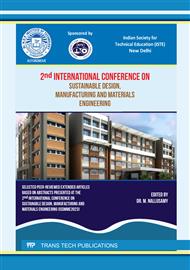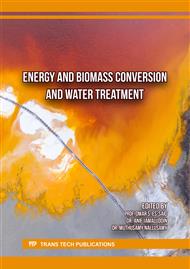[1]
Y.S. Shen, S.L. Wang, S.T. Huang, Y.M. Tzou, J.H. Huang, Biosorption of Cr (VI) by coconut coir: spectroscopic investigation on the reaction mechanism of Cr (VI) with lignocellulosic material, J. Hazard. Mater. 179 (2010), pp.160-165
DOI: 10.1016/j.jhazmat.2010.02.073
Google Scholar
[2]
M. Ciopec, C.M. Davidescu, A. Negrea, I. Grozav, L. Lupa, P. Negrea, et al. Adsorption studies of Cr(III) ions from aqueous solutions by DEHPA impregnated onto Amberlite XAD7-factorial design analysis, Chem. Eng. J., 90 (2012), pp.1660-1670
DOI: 10.1016/j.cherd.2012.01.016
Google Scholar
[3]
D. Mohan Jr., C.U. Pitman, Activated carbons and low cost adsorbents for remediation of tri- and hexavalent chromium from water, J. Hazard. Mater, 137 (2006), pp.762-811
DOI: 10.1016/j.jhazmat.2006.06.060
Google Scholar
[4]
P.K. Ghosh, Hexavalent chromium [Cr(VI)] removal by acid modified waste activated carbons, J. Hazard. Mater, 171 (2009), pp.116-122
DOI: 10.1016/j.jhazmat.2009.05.121
Google Scholar
[5]
P. Beneitez, S. Ayllon, Extraction studies on the system between bis (2- ethylhexyl) phosphoric acid and chromium(III) in several aqueous solutions, Solv. Extr. Ion Exch, 5 (1987), pp.597-609
DOI: 10.1080/07366298708918583
Google Scholar
[6]
B.G. Fraser, M.D. Pritzker, R.L. Legge, Development of liquid membrane pertraction for the removal and recovery of chromium from aqueous effluents, Sep. Sci. Technol, 29 (1994), pp.2097-2116
DOI: 10.1080/01496399408002192
Google Scholar
[7]
S.B. Lalvani, T. Wiltowski, A.H. Hubner, A. Weston, N. Mandich, Removal of hexavalent chromium and metal cations by a selective and novel carbon adsorbent, Carbon, 36 (1998), pp.1219-1226
DOI: 10.1016/s0008-6223(98)00102-x
Google Scholar
[8]
A.H. Sulaymon, B.A. Abid, J.A. Al-Najar, Removal of lead copper chromium and cobalt ions onto granular activated carbon in batch and fixed-bed adsorbers, Chem. Eng. J., 155 (2009), pp.647-653
DOI: 10.1016/j.cej.2009.08.021
Google Scholar
[9]
S. Babel, T.A. Kurniawan, Cr(VI) removal from synthetic wastewater using coconut shell charcoal and commercial activated carbon modified with oxidizing agents and/or chitosan, Chemosphere, 54 (2004), pp.951-967
DOI: 10.1016/j.chemosphere.2003.10.001
Google Scholar
[10]
J. Anandkumar, B. Mandal, Removal of Cr(VI) from aqueous solution using Bael fruit (Aegle marmelos correa) shell as an adsorbent, J. Hazard. Mater, 168 (2009), pp.633-640
DOI: 10.1016/j.jhazmat.2009.02.136
Google Scholar
[11]
M. Dakiky, M. Khamis, A. Manassra, M. Mereb, Selective adsorption of chromium(VI) in industrial wastewater using low-cost abundantly available adsorbents, Adv. Environ. Res, 6 (2002), pp.533-540
DOI: 10.1016/s1093-0191(01)00079-x
Google Scholar
[12]
Z.A.A. Othman, R. Ali, M. Naushad, Hexavalent chromium removal from aqueous medium by activated carbon prepared from peanut shell: adsorption kinetics, equilibrium and thermodynamic studies, Chem. Eng. J., 184 (2012), pp.238-247
DOI: 10.1016/j.cej.2012.01.048
Google Scholar
[13]
K. Selvi, S. Pattabi, K.K. Kaadirvelu, Removal of Cr(VI) from aqueous solution by adsorption onto activated carbon, Bioresour. Technol, 80 (2001), pp.87-90
DOI: 10.1016/s0960-8524(01)00068-2
Google Scholar
[14]
S.P. Dubey, K. Gopal, Adsorption of chromium (VI) on low cost adsorbents derived from agricultural waste material: a comparative study, J. Hazard. Mater, 145 (2007), pp.465-470
DOI: 10.1016/j.jhazmat.2006.11.041
Google Scholar
[15]
Solution by Hevea brasilinesis sawdust activated carbon, J. Hazard. Mater, B124 (2005), p.192
Google Scholar
[16]
I.C. Aloma, I. Rodriguez, M. Calero, G. Blazquez, Biosorption of Cr6+ from aqueous solution by sugarcane bagasse, Desalin. Water Treat, 52 (2014), pp.5912-5922
Google Scholar
[17]
S.S. Baral, S.N. Das, P. Rath, Hexavalent chromium removal from aqueous solution by adsorption on treated sawdust, Biochem. Eng. J., 31 (2006), pp.216-222
DOI: 10.1016/j.bej.2006.08.003
Google Scholar
[18]
United Nations Food and Agriculture Organization, Statistics Division Production/Crops of Mangoes Including Mangosteens and Guavas for 2013 (2013)
Google Scholar
[19]
Chatterjee S and Woo SH2009. The removal of nitrate from aqueous solutions by chitosan hydrogel beads. Journal of Hazard Mater 164: 1012-1018.
DOI: 10.1016/j.jhazmat.2008.09.001
Google Scholar
[20]
Demiral H and Gunduzoglu G 2010. Removal of nitrate from aqueous solutions by activated carbon prepared from sugar beet bagasse. Bioresource Technology 101: 1675–1680.
DOI: 10.1016/j.biortech.2009.09.087
Google Scholar
[21]
Geankoplis CJ 1993. Transport process and unit operations. Printice- Hall, NJ.
Google Scholar
[22]
Hassan ML, Kassem NF and El-Kader AHA2010. Novel Zr (IV)/sugar beet pulp composite for removal of sulfate and nitrate anions. Journal of Applied Polymer Science 117: 2205–2212.
DOI: 10.1002/app.32063
Google Scholar
[23]
T.M. Albayati, A.M. Doyle, Purification of aniline and nitrosubstituted aniline contaminants from aqueous solution using beta zeolite, Chem. Bulg. J. Sci. Educ 23 (2014) 105–114.
Google Scholar
[24]
IS: 10500, 1992.Drinking water standards of India. Jaafari K, Ruiz T, Elmaleh S, Coma J and Benkhouja K 2004. Simulation of a fixed bed adsorber packed with protonated cross-linked chitosan gel beads to remove nitrate from contaminated water. Chemical Engineering Journal 99: 153–160.
DOI: 10.1016/j.cej.2003.10.008
Google Scholar
[25]
Karimi M, Entezari MH and Chamsaz M 2010. Sorption studies of nitrate ion by a modified Beet residue in the presence and absence of ultrasound. 17: 711-717.
DOI: 10.1016/j.ultsonch.2009.12.002
Google Scholar
[26]
Keerthinarayana S 1994. Sorption of lindane from water environment by wood charcoal. Ph.D. Thesis Submitted to IIT, Kharagpur, W.B., India. Namasivayam and Höll WH 2005. Quaternized biomass as an anion exchanger for the removal of nitrate and other anions from water. Journal of Chemical Technology and Biotechnology 80:164–168.
DOI: 10.1002/jctb.1171
Google Scholar
[27]
Orlando US, Baes AU, Nishijima W and Okada M 2002. A new procedure to produce lignocellulosic anion exchangers from agricultural waste materials. Biorecourse Technology 83: 195–198.
DOI: 10.1016/s0960-8524(01)00220-6
Google Scholar
[28]
Öztürk N and Bekta TE 2004. Nitrate removal from aqueous solution by adsorption onto various materials. Journal of Hazard Mater 112:155–162.
DOI: 10.1016/j.jhazmat.2004.05.001
Google Scholar
[29]
ÖzcanAhin MS and Özcan AS 2005. Adsorption of nitrate ions onto sepiolite and surfactant-modified sepiolite. Adsorption. Science Technology 23:323–333.
DOI: 10.1260/0263617054769987
Google Scholar
[30]
Pirzabari M, Badriyha BN, and Milnter RJ 1991. GAC Adsorber Design for Removal of chlorinated pesticides, Journal of Environmental Engineering Division, ASCE 117(1):80-100.
DOI: 10.1061/(asce)0733-9372(1991)117:1(80)
Google Scholar
[31]
Senthil Rajan M, Prabhu P and Keerthinarayana S 2017. Biosorption Kinetices of Nitrate onto Tamrind Fruit Shells. Asian Journal of Research in Social Sciences and Humanities 6: 1-12.
DOI: 10.5958/2249-7315.2017.00326.4
Google Scholar



